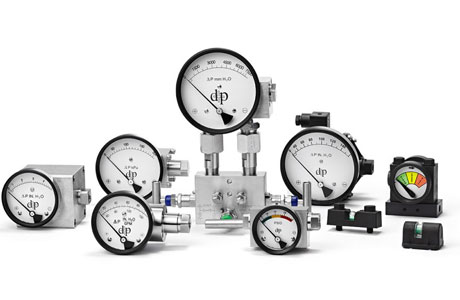How Does A Diaphragm Pressure Gauge Work?
Key Takeaway
A diaphragm pressure gauge uses a thin, flexible diaphragm to measure pressure. When pressure is applied, the diaphragm deflects proportionally. This movement is transferred to a pointer through a mechanical linkage or sensor.
Diaphragm gauges are ideal for measuring low pressures and are resistant to corrosive fluids. Their design ensures accurate and reliable readings in demanding environments.
Overview of Diaphragm Pressure Gauges
Diaphragm pressure gauges are essential tools for measuring and displaying pressure levels in various applications. These gauges use a diaphragm, a flexible membrane that deflects under pressure, to provide accurate readings. They are commonly used in industries such as chemical processing, oil and gas, and water treatment, where precise pressure monitoring is crucial.
The overview of diaphragm pressure gauges highlights their advantages, including their ability to handle corrosive media and withstand harsh environments. Understanding these features aids in selecting the appropriate gauge for specific needs, ensuring reliable performance and safety. By familiarizing oneself with diaphragm pressure gauges, professionals can enhance their pressure measurement capabilities.

Construction and Key Components of a Diaphragm Gauge
A diaphragm gauge is an essential instrument in measuring pressure, and its construction and key components play a critical role in its functionality. The primary component of a diaphragm gauge is the diaphragm itself, which is a thin, flexible membrane made from materials such as stainless steel, rubber, or plastic. This diaphragm is clamped between two flanges, creating a sealed chamber on one side. When pressure is applied to the chamber, the diaphragm deflects, and this movement is measured to determine the pressure level. This mechanism makes diaphragm gauges particularly suitable for measuring low-pressure ranges and in applications where high precision is required.
The diaphragm’s material selection is crucial, as it must withstand the specific pressure range and chemical environment of the application. Stainless steel diaphragms are commonly used for their durability and resistance to corrosion, making them ideal for industrial applications. In contrast, rubber or plastic diaphragms may be used in applications involving corrosive fluids or gases. The gauge also includes components such as a pointer, dial, and movement mechanism, which translate the diaphragm’s deflection into a readable pressure value. These components must be precisely calibrated to ensure accurate readings, making construction quality a critical factor in diaphragm gauge performance.
Diaphragm gauges offer several advantages, including their ability to measure both positive and negative pressures, making them versatile tools in various applications. They are also less susceptible to overpressure damage compared to other pressure gauges, enhancing their reliability and lifespan. Additionally, diaphragm gauges are available in different configurations, such as single-diaphragm and compound-diaphragm models, to suit specific measurement needs. Despite their advantages, diaphragm gauges must be regularly maintained and recalibrated to ensure accuracy and reliability. By understanding the construction and key components of a diaphragm gauge, users can make informed decisions about their selection and application, leading to improved measurement accuracy and operational efficiency.
Working Mechanism of Diaphragm Pressure Gauges
The operation of a diaphragm pressure gauge relies on the deformation of the diaphragm element:
1. Pressure Application: When pressure is applied to the diaphragm, it deforms proportionally to the force exerted.
2. Mechanical Movement: The deflection is transferred to a linkage mechanism that amplifies the motion.
3. Pressure Indication: The amplified movement drives the pointer on the dial, providing a pressure reading.
This simple yet effective mechanism ensures accurate measurements across various pressure ranges. Diaphragm gauges can handle pressures from vacuum levels to several hundred bar, depending on their design.
Advantages of Using Diaphragm Gauges in Specific Applications
Diaphragm pressure gauges offer numerous benefits, making them suitable for specific industrial needs:
1. Low-Pressure Measurement: Ideal for applications requiring accurate readings of minimal pressures.
2. Corrosion Resistance: The diaphragm can be made of materials resistant to aggressive chemicals or high temperatures.
3. Hygienic Design: Used in food and pharmaceutical industries due to their cleanable and contamination-resistant designs.
4. Versatility: Can measure absolute, gauge, or differential pressure.
5. Durability: Robust construction ensures long-term reliability even in harsh environments.
Their ability to handle challenging conditions makes diaphragm gauges indispensable in specialized applications.
Maintenance Tips for Ensuring Longevity of Diaphragm Gauges
Proper maintenance is essential to extend the life and accuracy of diaphragm pressure gauges:
1. Regular Calibration: Periodically calibrate the gauge to maintain accurate readings.
2. Inspect for Damage: Check the diaphragm for signs of wear, corrosion, or deformation.
3. Clean Thoroughly: Remove any residue or contaminants to prevent clogging and ensure proper function.
4. Avoid Overpressure: Use a gauge rated for your system’s maximum pressure to prevent diaphragm damage.
5. Protect from Vibration: Install vibration dampers to minimize wear and tear on internal components.
By following these practices, you can ensure optimal performance and longevity of your diaphragm pressure gauges.
Conclusion
A diaphragm pressure gauge operates by using a flexible diaphragm that deforms under pressure. This deformation is converted into a mechanical movement that drives a pointer on a dial, indicating the pressure level.
Diaphragm pressure gauges are highly sensitive and accurate, making them suitable for low-pressure applications and environments with corrosive media. They are commonly used in industries such as pharmaceuticals, food processing, and chemical manufacturing, where precise pressure measurement is critical.
